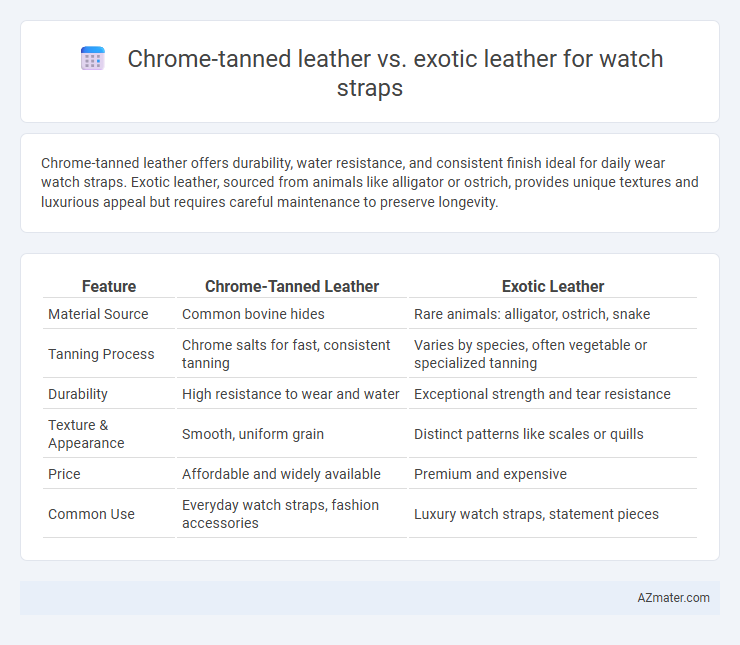Chrome-tanned leather offers durability, water resistance, and consistent finish ideal for daily wear watch straps. Exotic leather, sourced from animals like alligator or ostrich, provides unique textures and luxurious appeal but requires careful maintenance to preserve longevity.
Table of Comparison
| Feature | Chrome-Tanned Leather | Exotic Leather |
|---|---|---|
| Material Source | Common bovine hides | Rare animals: alligator, ostrich, snake |
| Tanning Process | Chrome salts for fast, consistent tanning | Varies by species, often vegetable or specialized tanning |
| Durability | High resistance to wear and water | Exceptional strength and tear resistance |
| Texture & Appearance | Smooth, uniform grain | Distinct patterns like scales or quills |
| Price | Affordable and widely available | Premium and expensive |
| Common Use | Everyday watch straps, fashion accessories | Luxury watch straps, statement pieces |
Introduction to Watch Strap Materials
Chrome-tanned leather offers durability and flexibility, making it a popular choice for watch straps due to its resistance to water and wear. Exotic leather, sourced from animals like alligator, ostrich, or python, provides unique textures and a luxurious aesthetic that enhances the watch's overall appeal. Both materials offer distinct advantages, with chrome-tanned leather excelling in practicality and exotic leather prized for its exclusivity and style.
Overview of Chrome-Tanned Leather
Chrome-tanned leather, widely used for watch straps, is treated with chromium salts, resulting in a durable, flexible, and water-resistant material that maintains its color and shape over time. This tanning method allows for faster processing and produces leather with a smooth, uniform surface ideal for everyday wear. Compared to exotic leathers, chrome-tanned leather offers a more affordable, versatile, and consistent option, making it popular for both casual and luxury watch straps.
Overview of Exotic Leathers (Alligator, Ostrich, etc.)
Exotic leathers such as alligator, ostrich, and lizard are prized for their unique textures, durability, and distinctive natural patterns, making them a luxurious choice for watch straps. Alligator leather is known for its tight, uniform scales and exceptional softness, while ostrich leather features characteristic quill follicles, offering flexibility and a striking appearance. These exotic materials provide a sophisticated alternative to chrome-tanned leather, which is typically smoother and more uniform but lacks the intricate detailing and exclusivity of exotic skins.
Durability and Longevity Comparison
Chrome-tanned leather offers superior durability due to its chemical tanning process, making it resistant to water, heat, and daily wear, which extends the lifespan of watch straps significantly. Exotic leathers such as alligator or ostrich, while prized for their unique textures and aesthetics, typically require more delicate care and can be more prone to scratches and environmental damage over time. For watch straps, chrome-tanned leather balances robustness and longevity with cost-efficiency, whereas exotic leather prioritizes luxury appearance but may necessitate more frequent maintenance to preserve its durability.
Comfort and Wearability Differences
Chrome-tanned leather watch straps offer superior softness and flexibility due to the chemical tanning process, enhancing comfort for prolonged wear. Exotic leather, sourced from animals like alligators or ostriches, often features unique textures and durable fibers but may require longer break-in periods, potentially reducing initial comfort. Wearability differences hinge on the smooth, pliable nature of chrome-tanned leather versus the distinctive yet stiffer exotic hides, influencing how each strap conforms to the wrist over time.
Aesthetics and Texture: Chrome-Tanned vs Exotic
Chrome-tanned leather offers a smooth, consistent texture with a polished finish, making it ideal for sleek, modern watch straps. Exotic leathers, such as alligator or ostrich, boast unique patterns and rich textures that provide a distinctive, luxurious appearance, enhancing the watch's visual appeal. The choice between chrome-tanned and exotic leather hinges on whether one prefers uniform elegance or bold, textured individuality.
Environmental Impact and Sustainability
Chrome-tanned leather, widely used for watch straps, involves chromium salts in the tanning process, which can release toxic waste harming soil and water ecosystems, raising concerns about its environmental impact. Exotic leathers, sourced from rare animals such as alligator or ostrich, often face scrutiny due to issues related to overhunting, habitat destruction, and limited scalability, challenging their sustainability credentials. Both materials present environmental challenges, but chrome-tanned leather's chemical waste and exotic leather's ethical sourcing issues require careful consideration when prioritizing sustainable watch strap options.
Price and Value Considerations
Chrome-tanned leather watch straps generally offer a more affordable option due to their efficient manufacturing process and consistent quality, making them suitable for everyday use without compromising durability. Exotic leather straps, such as alligator or ostrich, command higher prices driven by the rarity of materials and intricate craftsmanship, delivering a unique aesthetic and status symbol that enhances the timepiece's value. When considering price versus value, chrome-tanned leather provides cost-effective durability, while exotic leather justifies its premium through exclusivity and luxury appeal.
Maintenance and Care Requirements
Chrome-tanned leather watch straps require minimal maintenance, as their chemical treatment enhances resistance to water, stains, and wear, making them suitable for daily use with occasional cleaning using a damp cloth. Exotic leather straps, such as alligator, ostrich, or python, demand more careful upkeep, including conditioning with specialized leather care products and avoiding prolonged exposure to moisture and direct sunlight to prevent drying and cracking. Proper storage in a cool, dry place and gentle handling prolong the lifespan of exotic leather, while chrome-tanned leather remains relatively low-maintenance and durable.
Which Leather is Best for Your Watch Strap?
Chrome-tanned leather offers durability, softness, and water resistance, making it an excellent choice for daily wear watch straps that demand longevity and comfort. Exotic leathers such as alligator, ostrich, and python provide unique textures and luxurious aesthetics, appealing to those seeking a distinct, high-end look. The best leather for your watch strap depends on your priorities: choose chrome-tanned for practicality and resilience, or exotic leather for exclusive style and prestige.

Infographic: Chrome-tanned leather vs Exotic leather for Watch Strap
 azmater.com
azmater.com